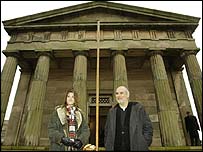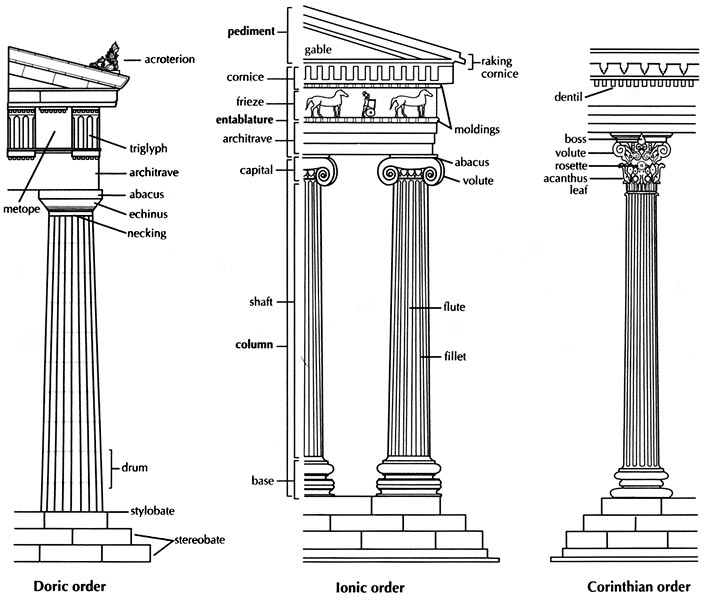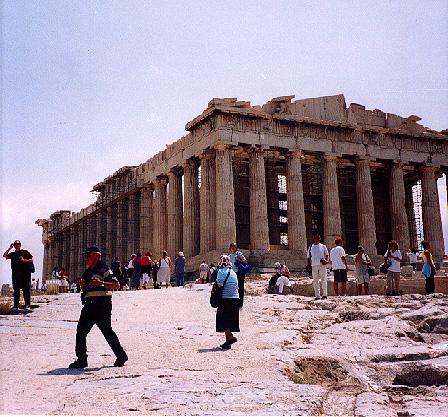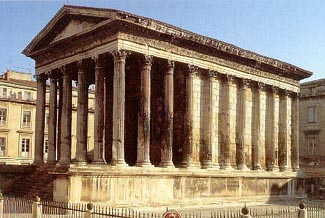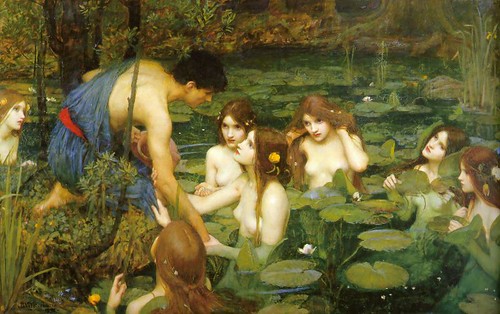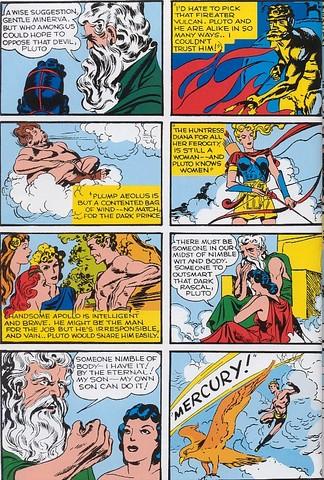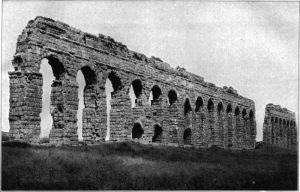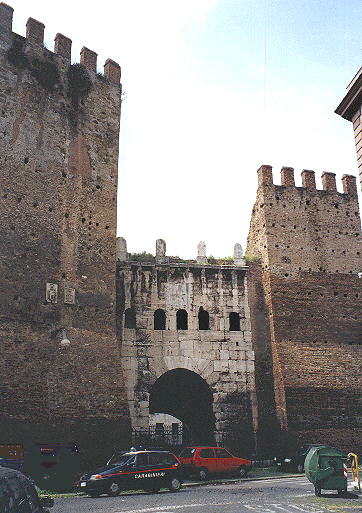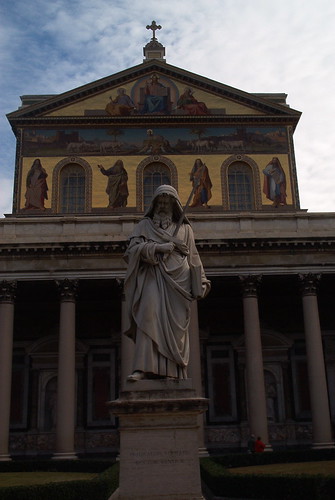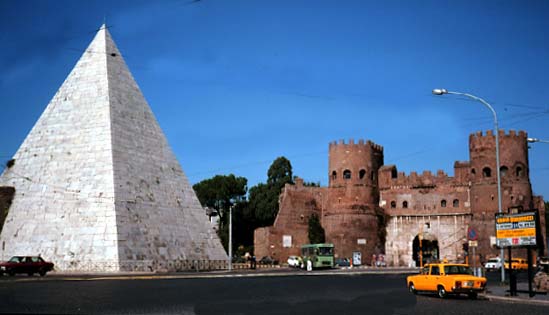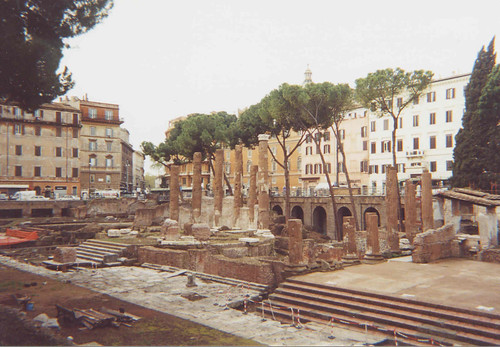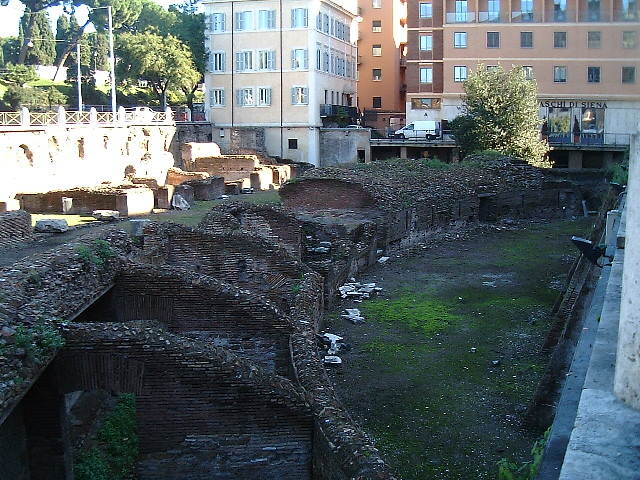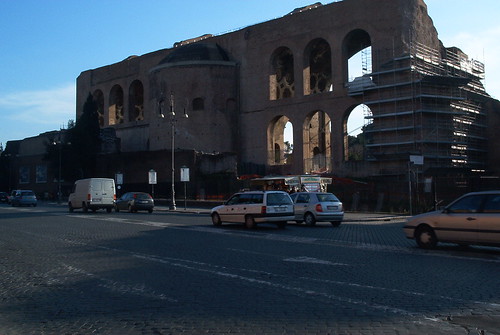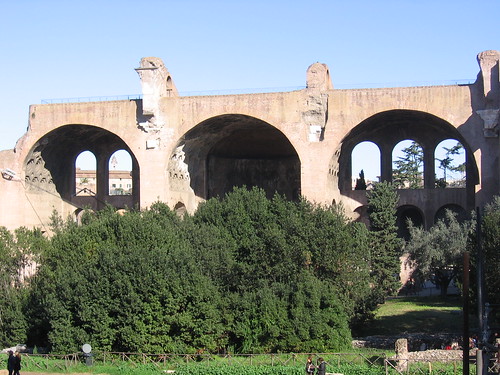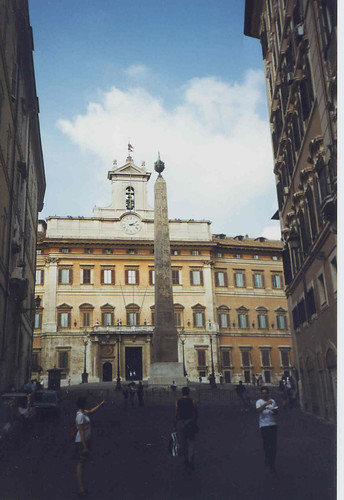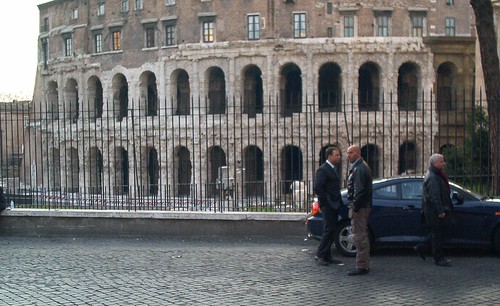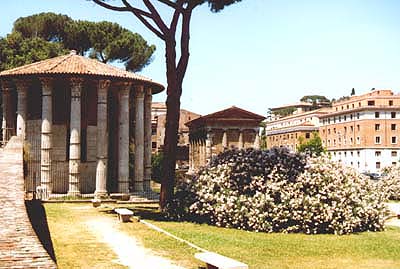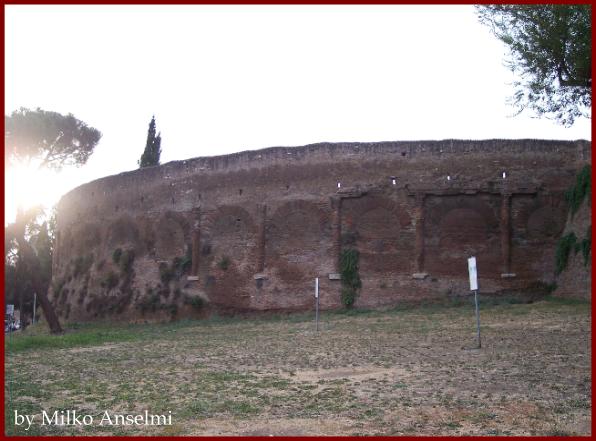(This is another older piece of writing from last year, revised a little. It's included here so that I won't unnecessarily repeat myself when I come to discuss Michael Wood's programme on King Arthur.)
The following is an attack on the historical accuracy claimed for
King Arthur the film, followed by a wider rant on Arthurian scholarship.[1]
Had King Arthur (directed by Antoine Fuqua, produced by Jerry Bruckheimer) presented itself as just another reinterpretation of the Arthurian myth, I wouldn't have minded so much. If the selling point was screenwriter David Franzoni's original idea,[2] 'King Arthur as The Wild Bunch', I could have sat back and let it wash over me. Of course, I might have been displeased that one of the great romances of western literature, Arthur, Guinevere and Lancelot, is reduced to 'Lancelot saw her naked once and had some dirty thoughts', and I might note that there is only one imaginative scene and one memorable piece of dialogue, and I might further have complained about how dull and clichéd, and indeed absurd, the whole exercise is, but that's another issue. After all, I'm quite happy to let creators change legends how they like, as I have said elsewhere about Wolfgang Petersen's Troy.
But Troy doesn't set itself up as history. King Arthur, on the other hand, is keen that the audience should accept it as 'historically accurate'. One of its promotional taglines is 'The untold true story that inspired the legend'. And it is on this level that I must attack it.
The film begins with a caption telling us that historians agree that there must be a historical figure behind the Arthurian legend. Well, no, there are a good number of historians who don't agree that at all. Then the film immediately runs into a voiceover, establishing for the audience that about ad 300 the ever-expanding Roman empire conquered the Sarmatians, dwellers on the Russian steppes, in what is now the Ukraine, and proceeded to establish regular recruiting of troops from them. These troops were sent to Britain, where they were traditionally commanded by a man called Artorius.
Wrong, wrong and thrice wrong. The Roman empire stopped expanding long before ad 300. It never conquered the Ukrainian steppes. Rome did interact with the Sarmatians, but the circumstances were rather different. The Sarmatians concerned had moved from the steppes to living just beyond the Danube, next to the Roman frontier. The emperor Marcus Aurelius tried to conquer them in the 170s ad, but had to abandon the attempt, due to a crisis elsewhere in the empire. As part of a quick peace deal, the Sarmatians provided eight thousand cavalry, five thousand, five hundred of which were sent to Britain. This seems to have been a one-off deal. Rome did not maintain dominion in the area - indeed, several later emperors had to fight further wars against the Danubian Sarmatians. There was still a Sarmatian unit in Britain at the end of the fourth century ad, but there's a strong possibility that by this time auxiliary units of the Roman empire recruited locally, rather than from the area in which they were originally raised. I'll get around to Artorius later.
The publicity for the film made a big thing of wanting to set Arthur in his real context, the aftermath of the Roman withdrawal from Britain. This is hardly a new idea, at least in terms of literature - Rosemary Sutcliff did it in the late 1950s and early 1960s in The Lantern Bearers and The Sword At Sunset, and Arthur of the Britons was a similarly-themed television series in 1972. Stephen Baxter has just done the same in his 2003 novel Coalescent. So what are we presented with in King Arthur?
The main action takes place in ad 467. Arthur is a Roman officer, Lucius Artorius Castus, but with a British mother (instantly presenting a division between conqueror and conquered that was probably irrelevant by the fifth century ad). Rome dominates Europe, but is pulling back from outlying provinces like Britain. Bishop Germanus has been sent to supervise the withdrawal.
But that isn't how it happened. Rome withdrew from Britain about a half-century before the film is set - the date is usually given as ad 410, and that's probably about right. And there was no formal withdrawal. Rather, the bulk of what legionary troops were left in the province were taken about ad 407 by Constantine III to support his (unsuccessful) bid for the imperial throne. Though the Britons subsequently offered to return to the fold, Rome never formally attempted to reassert direct rule, though trade and diplomatic connections remained (especially through the Church). This was because the western provinces, though formally still part of the empire, were by now composed of a mish-mash of areas still directly administered by Rome and barbarian kingdoms that only nominally acknowledged the emperor.
By ad 467 the situation was even worse. After the assassination of Valentinian III in ad 455, the western empire rapidly fell to puppet rulers appointed by Germanic warlords, seeking recognition from the eastern empire in Constantinople (which in the film never gets a mention). The western emperor's authority barely extended beyond Italy.
Bishop Germanus was real, and did really visit Britain, first in the late 420s ad. But by ad 467 he'd been dead for perhaps as much as twenty years, or maybe more. He had come to Britain to fight the heresy of Pelagius, who also gets mentioned in the film, as the man who has inspired Arthur's views about equality for all (a distortion of what Pelagius' actual views appear to have been). In a scene cut from the theatrical release, but restored in the 'Director's Cut' DVD, the young Arthur is seen in conversation with Pelagius. This restores a bit of Pelagius' Christian context, which the movie had otherwise stripped him of, but this scene is supposed to be in ad 452, and Pelagius went to Rome in ad 380, so even if he were still alive (which he probably wasn't - he seems to have died about ad 420) he can't have been this healthy fifty-year old seen.
(An aside: The more I think about it, the more I see a disturbing anti-Catholic element in this film. It's not anti-Christian; though Pelagius is largely stripped of his religious context - more so, as noted, in the theatrical release than in the Director's Cut - Arthur remains a good Christian. But Germanus dresses like a Catholic bishop - originally he was meant to be an anachronistic Cardinal, which makes it even more obvious; he is overtly Italian, as are other characters closely associated with the Church authorities; they're all clearly more interested in power and politics than in saving souls; the impression is given that the Pope is head of the Roman empire - no mention is made of an emperor; and there's even a mini-Inquisition going on. I'm quite surprised there hasn't been a hoo-hah about this, as this film is more anti-Catholic than The Passion of the Christ is anti-Semitic.)
Much of the historical action, therefore, has been placed decades later than when it belongs. On the other hand, the climactic battle is named as being Badon Hill. Badon Hill was a historical battle, that we know took place no earlier than ad 490, and probably no later than ad 515. That event has been brought forward.
So why has the film chosen ad 467 as its date? No idea. It might be connected with a British leader, Riothamus, who led a force into Gaul in the 470s ad at the request of the western emperor Anthemius, and who has been advanced as another possible 'real' Arthur. But no mention of the name Riothamus is made.
The film is full of other inaccuracies and anachronisms. The troops are all in recognizable Roman uniforms. Unfortunately, what most of us think of as Roman uniforms date to the first and second centuries ad. By the fifth century, uniforms and equipment were very different, and more like what we think of mediaeval soldiers wearing.
Arthur and his knights are ordered to rescue a Roman family (headed by poor Ken Stott, required to speak in a stupid Chico Marx-style Italian accent that makes you expect him to start singing the joys of Italian ice cream at any moment) living in a villa north of Hadrian's Wall. But there weren't villas north of the Wall. In any case, most villa owners came from the same Celtic élites that had always been the landowners. There wasn't much Italian settlement of this kind. This villa is just an excuse for an expedition into Injun territory - King Arthur as Western again. As I note above, Franzoni has said that his idea was 'King Arthur as The Wild Bunch', but I think he's just using Peckinpah's film as generic code for 'western', because that certainly isn't the film he's written. What he's actually imitating is the John Ford cavalry western - King Arthur as She Wore A Yellow Ribbon.* That's why there's a villa beyond the Wall – it's transferring the conditions of the American frontier in the 1870s to late Roman Britain.[3]
And the Saxons attack from north of Hadrian's Wall. Again, nonsense. The Saxons had light boats, not capable of long sea journeys. So they started landing at Kent, and then spread out from there. They crossed the Wall northwards into Scotland, not the other way round. (And I'm not going to mention crossbows!) There were threats to late Roman and post-Roman Britain from north of the Wall, but they were not Saxons.
Also, if you're going to give the characters names from the Arthurian legend, why select Lancelot, almost certainly a mediaeval French invention? Why not Kay, or Bedivere, who are associated much earlier with the Arthurian cycle? The answer, of course, has more to do with providing Hollywood entertainment than any desire for accuracy.
And what's all this with the 'Woads'? Why not call them 'Picts', since that's who they are? Perhaps to pretend that the Picts and the Britons are the same, something further implied with Guinevere's impersonation of Boudicca - again, the situation was rather more complex than that. But, of course, the film falls into standard Hollywood epic cliché. Rome is the evil empire, enslaving the subject races of other lands. The native Britons are freedom-loving, and 'want their country back'. This depiction of as oppressor can be seen in many Hollywood films, but its presence here further undermines King Arthur's claims to historicity. As for Guinevere as a warrior woman, whilst Keira Knightley asserts in a documentary that accompanies the DVD that "it's a historical fact that women fought the same as men", the reality is a lot more complicated than that. For a start, this is usually asserted for the Celto-British tribes at the time of the Roman invasion. The conditions that apply in pre-Roman Britain don't necessarily apply in early Pictish Scotland, though it suits the film's ideology, which sees the Picts as part of a continuing Celtic resistance against Rome, to assume that they do.
Then, it has to be pointed out that the ideas about the British warrior woman come from a few reference in Roman historians writing about the Boudiccan revolt, exaggerated by the baroque notions of seventeenth and eighteenth-century antiquarians. Yes, there are references to women amongst the ranks, and of course Boudicca herself. But one thing that has to be remembered is that Roman historians (and, indeed, the antiquarians) are portraying these non-Roman cultures as transgressing cultural norms. So just because Roman historians write of warrior women, it doesn't necessarily follow that they really existed. More evidence from the archaeological side is needed before we could necessarily believe the Roman reports.
Even if we do accept that there were women amongst the ranks of Celtic troops, we don't know what their actual role was, and we can't say for sure that they actually undertook any fighting. So, asserting that it's a historical fact that Celtic women fought on the same level as men is at the very least an over-simplification. Of course, all the Keira fighting stuff has nothing to do with any desire to be historical anyway - it's all about trying to capture the Buffy/Xena market.
Still, the film's historical consultants are keen to defend it.[4] 'The story created by Franzoni is fiction, but, as with all good historical fiction, it draws heavily on historical facts,' says Linda A. Malcor. However, good historical fiction tries to fit its narrative around what is known. It doesn't create an entirely false historical background against which to set its story.
At the basis of the film's portrayal of Arthur is the theory that identifies the 'original' Arthur as Lucius Artorius Castus, a Roman commander named in a pair of inscriptions from Dalmatia (ILS 2770). This Artorius, so the theory goes, was the leader of the Sarmatian cavalry forces, and he and they distinguished themselves in fighting around Hadrian's Wall, when Pictish barbarians invaded in the reign of Commodus. This theory has been expounded by Malcor, among others.[5]
Malcor's article detailing the biography of Lucius Artorius Castus and his connection with the Sarmatians, is, I have to say, one of the poorest examples of 'scholarship' it's been my misfortune to read. She submits that Artorius commanded the Sarmatians in Britain in the late second century. She does this because ... well, she doesn't really bother telling the reader that. As far as I can tell, the reason for believing this is that Artorius served on the Danube frontier, and was probably involved in dealing with the Sarmatians there. Yet if you look at what she says about his earlier career, she argues that he must have got to know the Sarmatians when he was on the Danube, because we know he later took command of them! Can we say 'circular argument', children? Her whole piece is like this. Important assertions are made without evidence. Hypotheses become 'facts', upon which further hypotheses are built, which in their own turn become 'facts'.
To be fair to Malcor (fairer, perhaps, than she deserves), I don't think she's the first to come up with the association of Artorius Castus and the Sarmatians. It may well be in Peter Turner's The Real King Arthur (1993), who certainly argues that the 'real' Arthur was a descendant of Artorius Castus - though given that the latter went back to Dalmatia on retirement it seems implausible that his descendants returned to Britain. The Sarmatian connection is possibly also in Tadeusz Sulimirski, The Sarmatians (1970). (I've seen neither of these works.) Artorius' command of the Sarmatians is now treated in popular accounts as if it were accepted fact, as is the idea that he and they performed spectacularly against a Pictish invasion in the late second century.
However, as far as I can make out, there is no direct evidence to link Artorius and the Sarmatians. We know that Artorius had served on the Danube frontier. We know that he later served in Britain, as praefectus of the VI Legion Valeria Victrix, though we don't know what precisely that entailed (possibly it meant he was third-in-command of the Legion). We know that he subsequently led infantry and cavalry contingents from Britain in a campaign in Armorica (modern Brittany and Normandy).** But we don't know whether Sarmatians were included in that force, though since we know there were Sarmatian cavalry in Britain at the time, it's likely. But even if they were, there were other cavalry units in Britain, so it's not likely that Sarmatians formed all of Artorius' cavalry force, and we know the cavalry wasn't the sole component anyway. There is nothing to suggest that Artorius had ever commanded the Sarmatians in Britain. There isn't even any firm evidence that the Sarmatians served on Hadrian's Wall (though it's likely that vexillations did) or that Artorius did (though he may well have at least visited it). Nor is there anything that associates either with the Pictish invasion, though as the Sarmatians were in Britain at the time, they no doubt got caught up in the fighting. But there's nothing to say that they distinguished themselves in it, and we don't even know that Artorius was in Britain at this point.
That, at least, is the conclusion from the evidence I have been able to trace - but writing on Arthurian matters has an annoying habit of vaguely stating "there is evidence that shows ..." and then not indicating what that evidence actually is, leaving one unable to determine if this is based on something one has overlooked, or simply overly hopeful inference based on the commonly available information. Publicity articles for King Arthur in Empire and elsewhere made mention of an inscription that names Arthur and supports the film's version of history. I've not been able to track down an epigraphic text that matches the publicity materials' description, and I can't tell if this is something new, or the Artorius inscription, or the Artognou inscription from Tintagel, overinterpreted to the point of no longer being recognizable.
Malcor's biography of Artorius, however plausible it might be, must therefore be considered fictitious. Hence it becomes unsafe to argue that Artorius must have formed the basis for Arthur, as Malcor goes on to do in a subsequent piece. This second article is equally circular in its logic, demonstrating that Artorius' life has parallels with Arthur's by reconstructing the Roman's biography from Arthurian sources! She even includes Badon in Artorius' battles, despite the fact that we know this battle took place in the post-Roman period. And I do wonder, if Artorius had such a glorious career, why is it that his name leaves no trace in the historical record, only being known from epigraphy.
This, in any case, is not Franzoni's Arthur. For the film, Artorius Castus is transported to a point two hundred and fifty years later. The explanation? Either the Sarmatian commander was traditionally called Artorius, or command of the Sarmatians passed from father to son (it is a measure of the sort of film we're dealing with that it never makes up its mind which of these options to choose).
Neither is at all plausible. The idea that images from Sarmatian culture and mythology have got into the developed mediaeval romance version of the Arthurian cycle is quite difficult to disprove, though my impression is that there is wishful thinking and overlooking of alternate explanations involved on the part of its proponents (and, as an online reviewer has pointed out, since these Sarmatian stories weren't written down until the nineteenth century, it is entirely possible that the images reminiscent of Sir Thomas Malory have actually come from Malory). The whole Sarmatian hypothesis remains just that, a hypothesis, however many parallels can be found. It cannot be supported by the historically-unsound association of Artorius Castus with the Sarmatians.
The film's other advisor, John Matthews, does not appear much better, at least in interviews done in connection with the film. He is quite convinced that 'Camelot' derives from Roman Camboglanna, despite the fact that the name doesn't appear in an Arthurian source before the twelfth century (people seeking for the 'real' Arthur sometimes seem to have a real problem with the notion that Geoffrey of Monmouth, Chrétien de Troyes or Malory might ever have made stuff up). Thus he places Arthur at the fort of Birdoswald, supporting the contention with the evidence (which is undeniable) that someone dominated the local area from the fort in post-Roman times. Now, I have no doubt that the sort of person who was in charge at Birdoswald in the post-Roman period contributed to the Arthur legend. But that's as far as one can go. Also, Matthews is seemingly unaware (or chooses not to accept) that, though it used to be thought that Birdoswald was called Camboglanna, modern scholarship believes the name was probably Banna, and assigns Camboglanna to the next fort westwards, Castlesteads. (Nor does he seem to care that the Sarmatians in Britain came from the Danube lands, and not the Ukraine or Georgia.)
The trouble with Malcor and Matthews is a problem with a lot of Arthurian writing (at least, that side of it which doesn't concentrate on the literary aspects of the legend's retellings). People write on the subject who have been gripped by the power of the legend, and want to believe. They desperately want to demonstrate that Arthur really lived, and where he operated, and that their theory will command respect where others have failed. As a result, people don't stop when the evidence does. Let's take another example, that of Riothamus mentioned above, whose continental expedition is sometimes thought to be the model for Geoffrey of Monmouth's tale of Arthur's war with Rome in Gaul. Riothamus, modern writers say, seems to have died on the way to a place called Avalon. Pretty intriguing, eh? Except that's not actually what the ancient source says. Here it is, Jordanes, writing in The Origins and Deeds of the Goths:
Euric, king of the Visigoths, came against them with an innumerable army, and after a long fight he routed Riothamus, king of the Britons, before the Romans could join him. So when he had lost a great part of his army, he fled with all the men he could gather together, and came to the Burgundians, a neighbouring tribe then allied to the Romans. But Euric, king of the Visigoths, seized the Gallic city of Arverna for the Emperor Anthemius was now dead.
Now, first of all, there's nothing about Riothamus dying. We simply don't know his fate. Secondly, though one might note a similarity between the names Arverna (modern Clermont-Ferrand) and Avalon, this isn't indisputably where Riothamus is said to have been going, even though we know from a letter of Sidonius Apollinaris that Riothamus had diplomatic links with the city. It was Euric the Visigoth who actually went there. Riothamus was off to the Burgundians, who admittedly lived not far to the east of Arverna; but it is wishful thinking to state that the source definitely shows Riothamus heading for Arverna/Avalon.
In the end, the whole quest for the historical Arthur, which informs the movie's claims to authenticity, may well be a wild goose chase. It's entirely possible that one of the many post-Roman British warlords was called Arthur. But Arthur is absent from
the account of Gildas, who lived when Arthur is supposed to, and indeed from the Venerable Bede, and this is not trivial.
I don't think I'd go as far as saying Gildas proves that there wasn't a historical Arthur. For a start, I think Gildas has been misread. Gildas is usually taken as saying that Ambrosius Aurelianus, not Arthur, was victor at Badon. Since there's some suggestion in other sources that Ambrosius opposed Vortigern, probably in the late 440s
ad, the idea that he was also victor at Badon c. 500
ad has resulted in Ambrosius Aurelianus' history being more confused than it need be. This being arguably too long a period for the activities of a single individual, it has lead to a hypothesis of an older Ambrosius and a younger one, to cover his whole career. But, contrary to what most books state, Gildas does not say that Ambrosius was the victor of Badon. He states that Ambrosius emerged as British war leader, and stiffened resistance to the Saxons. After this, Gildas foes on to state, there were a series of wars, that culminated in Badon. It's an understandable inference from that to associate Badon and Ambrosius, but unsound in such a compressed and idiosyncratic account as Gildas.
But I do think that Arthur's absence from Gildas' account shows that, if he did exist, he certainly wasn't as important as later tradition makes him out to be. If there was there was an 'Arthur', i.e. a heroic British/Romano-British leader who was successful against the Saxons. Perhaps he was indeed, as later tradition has it, the leader at Badon, which is after all one of the two battles earliest associated with Arthur (the other being Camlann), and the only one we know for certain took place. Maybe he was not significant enough for Gildas to mention, but grew in fame as the story was retold. But there's no agreement even of where the name came from. 'Art-' isn't that common a start to a Roman name, so there may not be a mass of Roman 'Arthurs'. But it's also been suggested that the name has Celtic roots. To those searching for the One True Arthur, of course, the name must be either Roman
or Celtic, but I suspect both roots may contribute to the legend.
But we will never know for sure. By the time he appears in records, the historical Arthur, if he ever existed, has already developed beyond recognition. There is an obscure reference to Arthur, saying that someone 'was no Arthur', in a Welsh poem
Y Gododdin, which perhaps originally dates from c. AD 600. But this may be a tenth-century interpolation into the text. On the other hand, it may be evidence that Arthur began as a Welsh mythical hero - 'he was no Arthur' could be the equivalent of 'he was no Hercules'. (Or it may simply be an adjective meaning 'bear-like'.)
In any case, this figure has already accrued to himself the actions of many other Dark Age warlords, such as the shadowy but undoubtedly historical Ambrosius Aurelianus, or indeed Riothamus. Perhaps, as has been suggested, the British usurper emperor Magnus Maximus, who seems to have strengthened Britain's defences against the Saxons, went into the mix (possibly when Geoffrey was writing), and maybe even (though personally I doubt it) Lucius Artorius Castus. But beyond all the historical figures, the Arthur we know has also been touched with Irish and Welsh legend, and Celtic Iron Age and perhaps even Bronze Age practices. Maybe some Sarmatian stories did get in there.
But it's silly to suggest that Cumbria, or Wales, or the south-west, is
the setting for Arthur - all will have made their contribution to the evolving legend. In the end, the Arthur who unites the Britons in the wake of the collapse of Roman control is just as much a literary construct as the chivalric Arthur of the mediaeval romances. Possibly a historical figure called Arthur stands behind the legend, which certainly incorporates some elements drawn from the reality of post-Roman Britain (as Guy de la Bédoyère says in Francis Pryor’s
Britain A.D. television series). Whether or not there was a historical Arthur in some ways isn't the point, and in any case is a question that cannot be answered. All we can do is to trace the evolution of the legend. We may be able to take that back some way, but never quite far enough. Like the Questing Beast that King Pellinore forever chases but never catches, the 'real' Arthur is forever just beyond our reach.
Somebody asked me if, given all this, I had a favourite modern version of the Arthur myth. 'Yes,' I replied. '
Monty Python and the Holy Grail.'
[1] The Arthurian scholarship I'm having a go at is that seeking for the historical Arthur. I have no problem with literary Arthurian scholarship that concentrates on the stories as stories.
[2] In an article by Kate McCallum, 'The Great Idea: The Historical Epic Feature and the Creation and making of King Arthur', in Scr(i)pt 10.4 (July/August 2004), pp. 32-35, Franzoni explains the rationale behind his version of the Arthurian legend. Unfortunately, anti-Britishness colours Franzoni's responses to criticism.
[3] Bruckheimer and Fuqua, in the meantime, seem to have wanted to remake The Lord of the Rings, to judge from the lingering aerial scenery shots, etc.
[4] See this BBC news report: 'King Arthur film history defended'.
[5] 'Lucius Artorius Castus. Part 1: An Officer and an Equestrian', The Heroic Age, Issue 1, Spring/Summer 1999; 'Lucius Artorius Castus. Part 2: The Battles in Britain', The Heroic Age, Issue 2, Autumn/Winter 1999.
* Later note: It's been mentioned elsewhere that the expedition north of the Wall has similarities to the plot of Fuqua's previous film, Tears of the Sun. So it may be that film at this point isn't representing Franzoni's original screenplay, but a subsequent rewrite drawing on Tears.
** Later note: The Latin description of this command is duci leg cohortium alarum Britaniciniarum. Malcor translates this as "dux of the legions of cohorts of cavalry from Britain", but that cannot be correct. Ala is not the word for cavalry, but for a cavalry unit, equvalent to 'cohort'. So the genetive alarum cannot depend upon cohortium, since alae were not organized into cohorts, but upon duci, indicating that Artorius was "dux of cohorts [and] of alae", i.e. led a mixed infantry and cavalry force. The abbreviaton leg probably indicates that the cohorts were drawn from the legions rather than being auxiliary units.

